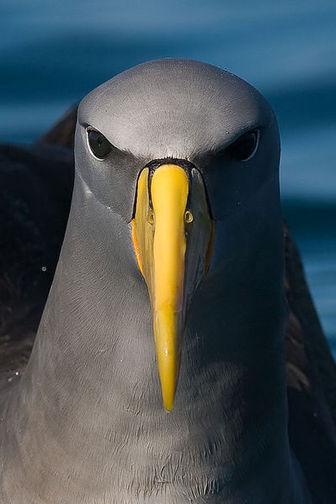Chatham Albatross
The Chatham Albatross, Chatham Mollymawk, or Chatham Islands Mollymawk, Thalassarche eremita, is a medium-sized black-and-white albatross which breeds only on The Pyramid, a large rock stack in the Chatham Islands, New Zealand. It is sometimes treated as a subspecies of the Shy Albatross Thalassarche cauta. It is the smallest of the Shy Albatross group.

Original source: Craig Nash
Author: Craig Nash
The Chatham Albatross is classified as Critically Endangered (CR), facing an extremely high risk of extinction in the wild.
The Chatham Albatross was first described as Diomedea cauta eremita by Robert Cushman Murphy, in 1930, based on a specimen from Pyramid Rock, Chatham Islands. Description - The Chatham Albatross weighs 3.1–4.7 kg (6.8–10 lb) and it has a length of 90 cm (35 in). The adult has a dark grey crown, face, upper mantle, back, upperwing, tail, and throat. They have a white rump and underparts. More
Albatross, and Chatham Albatross were all considered the same species until a 1998 book by Robertson and Nunn. Other experts followed suit, with BirdLife International in 2000, Brooke in 2004, ACAP in 2006, and SACC in 2008. Though some, like James Clements (at the time of his death) didn't agree, nor has Cornell University since (which is responsible for his book). More
The Chatham albatross nests on rocky ledges and steep slopes (5). They forage in oceans over the continental slope, particularly in areas of upwelling (4). Biology - Due to the difficult access of the Pyramid islet, and the frequently challenging sea and weather conditions surrounding it, the Chatham albatross remains one of the least known of the world’s albatross species (2) (5). More
Chatham albatross has grey-black plumage on the back, tail and upper sides of the wings, while the rump and underparts are white. The crown, face and throat are dark grey, contrasting with the sharp bill, which is bright yellow with a dark spot at the tip of the lower mandible. Juveniles have more grey plumage and a blue-grey bill, with black tips to both mandibles (3). More
extreme storm in 1985 and, while Chatham Albatross were not as severely affected as Northern Royal Albatross Diomedea sanfordi on the Forty-fours, the species is consequently classified as Critically Endangered. Past trends are unknown but there is no current evidence of a population decline. More
A Chatham albatross in flight is a magnificent sight. With more than twice the wingspan of our common black-backed gulls, the Chatham albatross glides at more than 80kph, yet seemingly exerts only infinitesimal effort to achieve these enormous speeds. More
During the 1980's two Chatham Albatrosses were regular visitors to Albatross Island in the Bass Strait between Tasmania and mainland Australia (Tickell 2000). Chatham Albatross is listed as Critically endangered by the IUCP. This species is confined to an extremely small area when breeding and risks include habitat loss, destruction of local environment (eg. oil spill) and disease. The vegetation and soil on Pyramid Rock is subject to periodic damage from storms and this affects the stability of the nests. More
Every year, Chatham albatrosses return to breed on a single rock stack, called the Pyramid, in the Chatham Islands, New Zealand. In the mid-1980s, severe storms damaged this breeding habitat. Although the habitat is slowly recovering, this had a considerable impact on the breeding success of this albatross. However, it is believed that fisheries-related deaths pose the greatest threat to the survival of this species. More
The Chatham albatross is critically endangered, with only about 11,000 of the birds remaining. Kennedy Warne * EcoCenter: Oceans The Amazing Albatrosses = They fly 50 miles per hour. Go years without touching land. Predict the weather. Mate for life. And they're among the world's most endangered birds. More
The Chatham Albatross (Thalassarche eremita) is a medium-sized black-and-white albatross which breeds only on The Pyramid, a large rock stack in the Chatham Islands, New Zealand. It is sometimes treated as a subspecies of the Shy Albatross T. cauta. The islet on which this albatross breeds has undergone a significant decline in habitat condition, the bird is therefore listed on the IUCN Red List as Critically Endangered. The current population is estimated at 11,000. More
Chatham Albatross from the other side of the Southern Ocean inspired our teams and reminded them of the importance of our work. This day the albatross was safe, but on another day, it might have drowned on a longline. We must do everything in our power to prevent the needless slaughter of these birds: we have lost too many albatrosses in the past we are determined not to lose many more. More
Family : Diomedeidae
Genus : Thalassarche
Species : eremita
Authority : Murphy, 1930
